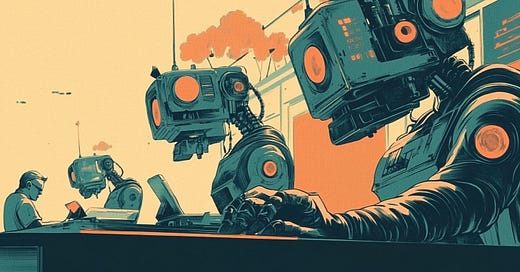✨ Some good news: The latest on AI and business
Artificial intelligence following the familiar script: big investment, slow returns, transformation ahead (we hope). Patience remains an asset
My fellow pro-growth/progress/abundance Up Wingers,
Economics historians, as well as longtime Faster, Please! readers, will recognize the script. A transformative technology emerges, investment surges, and then ... not so much happens.
This productivity J-curve — where performance initially dips before soaring — has characterized every general-purpose technology from the dynamo to the personal computer. The bank Goldman Sachs' second-quarter data suggest artificial intelligence is still following this well-worn path.
The parallels are striking if not exactly surprising. When electric dynamos replaced steam engines in the 1890s, productivity stagnated for nearly two decades while factories reorganized around distributed power. The PC revolution of the 1980s showed similar lags. Robert Solow famously quipped in 1987 that computers were everywhere except in the productivity statistics. Then came the 1990s productivity surge.
Today's AI boom exhibits comparable patterns. Since ChatGPT's late 2022 release, analysts have upgraded their end-2025 revenue projections for semiconductors by $200 billion (0.7 percent of US GDP) and AI hardware enablers by $105 billion (0.4 percent of GDP). From this elevated baseline, chipmaker revenues are projected to surge an additional 36 percent by 2026. The money continues to flow.
Yet economy-wide impacts remain elusive, despite all that investment, with some signs of momentum. AI adoption climbed to 9.2 percent of firms this quarter, up from 7.4 percent previously. That bump suggests the technology might be moving beyond experimental tinkering. Larger companies lead the charge, while education, information, finance, and professional firms are the sectors showing the steepest uptake curves.
Yet for all the algorithmic enthusiasm, familiar anxieties persist. Goldman: “Recent industry surveys suggest that businesses have grown the number of use cases for AI in production, but concerns around data security and sufficient infrastructure remain.”
Labor markets, too, are following historical precedent — at least so far. Despite breathless predictions of mass technological unemployment — and a sprinkling of business anecdotes — AI’s expected assault on workers remains more theoretical than actual. And again, the impact is narrow rather than broad.
Goldman: “AI-related job openings now account for 24 percent of all IT job openings and 1.5 percent of all job postings. AI has not been mentioned in major corporate layoff announcements in recent months and the unemployment rate for AI-exposed positions has reconciled with the broader unemployment rate.”
On the job front, some wise words in Time magazine from economist Erik Brynjolfsson, senior fellow at the Stanford Institute for Human-Centered AI and one of thinker behind the aforementioned J-Curve:
The idea is that AI will create so much wealth that the excess can be distributed to the general population, who will have abundant time for leisure and less remunerative pursuits. But this seems like pie-in-the-sky wishful thinking. … Expecting the owners of AI technologies to suddenly become benevolent distributors of wealth without structural incentives seems, at best, naive. But Brynjolfsson sees a more promising path based on conversations he’s had with more forward-looking executives. “When your workers become more productive, that’s exactly the time to hire more of those kinds of workers, not less,” he says. These executives envision AI as an opportunity for imagining new products and services and outpacing the competition. “Smart managers will lean into this because they will realize—and this is part of what I preach—that AI will let them do new things that they couldn’t do before,” Brynjolfsson says. “That's a much more sustainable competitive vision, in the interest of you and your stockholders, and you're going to get buy-in from your workers."
The emerging technological revolutions continues to unfold.
On sale everywhere The Conservative Futurist: How To Create the Sci-Fi World We Were Promised
Micro Reads
▶ Economics
The Missing Engineers - Bberg
Aerospace Was Ready to Take Off. Then Tariffs Landed. - Bberg Opinion
Is China Really Growing at 5 Percent? - The Fed
Let the Market Work - AEI
Flash Report: May Unemployment Flows Suggest Some Labor Market Weakening - Federal Reserve of St. Louis
▶ Business
▶ Policy/Politics
The AI lobby plants its flag in Washington - Politico
Time for Congress to save American science … and the nation - The Bulletin
▶ AI/Digital
College Grads Are Lab Rats in the Great AI Experiment - Bberg Opinion
▶ Biotech/Health
▶ Clean Energy/Climate
▶ Space/Transportation
▶ Up Wing/Down Wing
Is Harvard Worth Saving—and How? - WSJ Opinion
It May Feel Like the 1960s. But It’s Worse. - NYT Opinion
The Fatal Flaws of the Futureless Left - Jacobin
▶ Substacks/Newsletters
AI reports in 2025 Say we are Underestimating Its Impact - AI Supremacy
How to Regulate Radiation Exposure - Breakthrough Journal
Silicon Valley's quest to remove friction from our lives - Strange Loop Canon
America's Internal Brain Drain - The Permanent Problem
Some Economics of Africa’s Struggle - Conversable Economics
Working within Reason - Joshua Gans’ Newsletter
The Drivers of Age-Related Diseases - Ground Truths
AI is a Liquid, Not a Solid - by Miles Brundage - Miles Brundage






